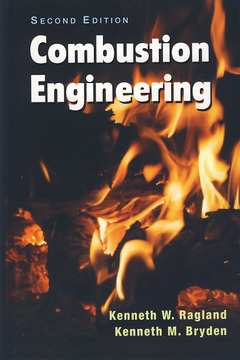Combustion engineering (2nd Ed.)
Auteurs : Ragland Kenneth W., Bryden Kenneth M.

Numerous tables featuring practical data and formulas support the design focus, and chapters include worked examples and problems. Mathematical methods are presented with qualitative descriptions of the methods used.
Engineering applications are detailed throughout, showing the range of combustion engineering and identifying the latest trends in combustion and fuels.
Introduction to Combustion Engineering
The Nature of Combustion
Combustion Emissions
Global Climate Change
Sustainability
World Energy Production
Structure of the Book
Section I: Basic Concepts
Fuels
Gaseous Fuels
Liquid Fuels
Solid Fuels
Problems
Thermodynamics of Combustion
Review of First Law Concepts
Properties of Mixtures
Combustion Stoichiometry
Chemical Energy
Chemical Equilibrium
Adiabatic Flame Temperature
Chemical Kinetics of Combustion
Elementary Reactions
Chain Reactions
Global Reactions
Nitric Oxide Kinetics
Reactions at a Solid Surface
Problems
References
Section II: Combustion of Gaseous and Vaporized Fuels
Flames
Laminar Premixed Flames
Laminar Flame Theory
Turbulent Premixed Flames
Explosion Limits
Diffusion Flames
Gas-Fired Furnaces and Boilers
Energy Balance and Efficiency
Fuel Substitution
Residential Gas Burners
Industrial Gas Burners
Utility Gas Burners
Low Swirl Gas Burners
Premixed-Charge Engine Combustion
Introduction to the Spark Ignition Engine
Engine Efficiency
One-Zone Model of Combustion in a Piston-Cylinder
Two-Zone Model of Combustion in a Piston-Cylinder
In-Cylinder Flame Structure
Combustion Chamber Design
Emission Controls
Ethanol Considerations
Review of Terminology for Premixed Gas, Four-Stroke Engines
Detonation of Gaseous Mixtures
Transition to Detonation
Steady-State Detonations
One-Dimensional Model for Propagation Velocity, Pressure, and Temperature Rise Across a Detonation
Maintained and Pulse Detonations
Section III: Combustion of Liquid Fuels
Spray Formation and Droplet Behavior
Spray Formation
Droplet Size Distributions
Fuel Injectors
Vaporization of Single Droplets
Oil-Fired Furnace Combustion
Oil-Fired Systems
Spray Combustion in Furnaces and Boilers
Plug Flow Model of a Uniform Field of Droplets
Emissions from Oil-Fired Furnaces and Boilers
Gas Turbine Spray Combustion
Gas Turbine Operating Parameters
Combustor Design
Combustion Rate
Liner Heat Transfer
Low Emissions Combustors
Diesel Engine Combustion
Introduction to Diesel Engine Combustion
Combustion Chamber Geometry and Flow Patterns
Fuel Injection
Ignition Delay
One-Zone Model and Rate of Combustion
Engine Emissions
Diesel Engine Improvements
Detonation of Liquid and Gaseous Mixtures
Detonation of Liquid Fuel Sprays
Detonation of Liquid Fuel Layers
Section IV: Combustion of Solid Fuels
Solid Fuel Combustion Mechanisms
Drying of Solid Fuels
Devolatilization of Solid Fuels
Char Combustion
Ash Formation
Fixed Bed Combustion
Biomass Cookstoves
Space Heating Stoves Using Logs
Grate Burning Systems for Heat and Power
Combustion Efficiency and Boiler Efficiency
Emissions from Grate Burning Systems
Modeling Combustion of Solid Fuels on a Grate
Suspension Burning
Pulverized Coal Burning Systems
Pulverized Coal Combustion
Behavior of Ash
Emissions from Pulverized Coal Boilers
Carbon Dioxide Capture and Sequestration
Biomass-Fired Boilers
Fluidized Bed Combustion
Fluidization Fundamentals
Combustion in a Bubbling Bed
Atmospheric Pressure Fluidized Bed Combustion Systems
Circulating Fluidized Beds
Pressurized Fluidized Bed Gasification of Biomass
Appendix A: Properties of Fuels
Appendix B: Properties of Air (at 1 atm)
Appendix C: Thermodynamic Properties of Combustion Products
Appendix D: Historical Perspective on Combustion Technology
Dr. Kenneth Ragland is an emeritus professor of mechanical engineering at the University of Wisconsin–Madison. Throughout his career, he taught courses in thermodynamics, fluid dynamics, combustion, and air pollution control. His early research was on solid fuel ram jet combustion, and gaseous and heterogeneous detonations. His research at UW–Madison focused on solid fuel combustion of coal and biomass as single particles, combustion in shallow and deep fixed beds, fluidized bed combustion, and combustion emissions. He served as chair of the Department of Mechanical Engineering from July 1995 until his retirement in July 1999. In retirement his research has focused on the development of systems for planting, harvesting, and combusting biomass crops for energy. Currently, he is the vice president of Energy Performance Systems, Inc.
Dr. Kenneth "Mark" Bryden joined the faculty of the Mechanical Engineering Department at Iowa State University in 1998 after receiving his doctoral degree in mechanical engineering from the University of Wisconsin–Madison. Prior to his studies at the University of Wisconsin–Madison, he worked fourteen years in a wide range of engineering positions at Westinghouse Electric Corporation. This included eight years in power plant operations and six years in power plant engineering. More than ten of these years were spent in engineering management. Mark has an active research and teaching program in the areas of energy, combustion, and appropriate technology. He is particularly interested in biomass combustion and small cookstoves for the developing world. He is president of Engineers for Technical and Humanitarian Opportunities for Service (ETHOS) and is the program director for the Simulation, Modeling and Decision Science Program at the U.S. Department of Energy’s Ames Laboratory. He teaches classes in combustion, sustainability, energy systems, and design for the developing world. He is th
Date de parution : 05-2011
Ouvrage de 518 p.
15.6x23.4 cm
Disponible chez l'éditeur (délai d'approvisionnement : 13 jours).
Prix indicatif 195,46 €
Ajouter au panierThèmes de Combustion engineering :
Mots-clés :
NOX Emission; Reduce NOX Emission; Combustion Chamber; Ame Speed; Chapman Jouguet Condition; Moisture Content; Air Fuel Ratio; Detonation Velocity; Spark Ignition Engine; Diesel Fuel; Spray Detonations; Equivalence Ratio; Crank Angle; Ame Front; Detonation Wave; Ignition Delay; Ame Temperature; Combustion Engineering; Ma Ma; Char Particle; Stoichiometric Fuel Air Ratio; SAE International; Ue Gas; Low NOX; CN



